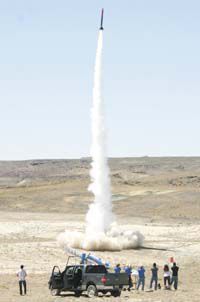| The rocket from Arizona State University launches into the desolate landscape outside of Green River. |
The desert near Green River is the perfect environment to explore the world of rockets. The White Sands Missile Base in New Mexico used Green River as a testing ground in the 1960s and 70s with the Athena and other rockets being launched from the Green River Test Site. But rocket launching is not just a part of Green River’s past it is part of their future, too, as modern rocket scientists (and their students) came to Green River to launch their creations near the river southeast of town. At a place near Crystal Geyser, the students and their mentors gathered in the 100 degree heat to construct and launch the rockets.
Three teams of students, one from Utah State University, one from Arizona State in Tempe, Ariz., and the final one from the Milwaukee School of Engineering in Wisconsin, came to the Utah desert to show their stuff. On hand to observe the competition were six judges from the aerospace industry and the world of academia.
These judges job is to rate each team on their projects and determine the winner of the Second Annual Intercollegiate Rocket Launch Competition. Before the launch competition began, the teams were required to send the judges an 11 page paper summarizing their rocket design. They must also give a 45 minute oral presentation summarizing their rocket design. This oral presentation took place at the John Wesley Powell River History Museum meeting room.
The Environmental Sounding Rocket Association, in conjunction with Alliance Technical Systems (formerly Thiokol) sponsor the competition for budding engineers to display their talents. Many aerospace engineers come out to the competition to watch and take notes on the quality of engineers being turned out by the universities. The future of the aerospace industry will be in the hands of the graduates of today.
At the launch site, the teams construct their rockets with the aim of launching it and its 10 pound payload 10,000 feet in the air. In addition to the successful launch, the team is required to recover the rocket and it must be in reusable condition. The payload must not be harmed and recoverable also. Maximum points are given to the team whose rocket reaches exactly 10,000 feet in altitude.
A barometric altimeter is installed in the rocket to produce a continuous readout of altitude which allows the team on the ground to know the exact height reached by the rocket. Within one hour of the recovery of the rocket, the team must submit a printout of the altitude to the judges.
| Members of the Utah State team and other helpers ready the fuel supply and the rocket. |
Paul Mueller, an assistant professor USU, said, “This competition is for students to show what they can do. This is the second annual competition and Green River has been good to us. We want this competition to grow and have many more teams. An observation team is here from UCLA with plans to compete in next year’s contest.”
Members of the team from Utah State University were: Wade Siddoway, Mike Hammond, Jim Sanders and Shannon Eilers. The team from Arizona State was: James Villarreal, Mark Sipperly, Jacob Dennis and Tom Villarreal. Representing the Milwaukee School of Engineering were: Brian VanRoy, Graham Motzing, Joe Nelson, Sarah Johnson and Matt Woodruff. The safety person for the competition was Ralph Haycock, an adjunct professor from USU.
First place: Milwaukee School of Engineering, with rocket that reached approximately 10,900 feet with fully functional payload and recovered flawlessly
Second place: Arizona State University
Third place: Utah State University
Jim Furfaro Award for Technical Excellence (best paper, presentation, student design, and student knowledge and professionalism): Arizona State University. This award is named in memory of Jim Furfaro, an aerospace engineer at ATK, judge at last year’s competition, and great supporter of student rocket projects who tragically died in an auto accident near Logan in 2006.

